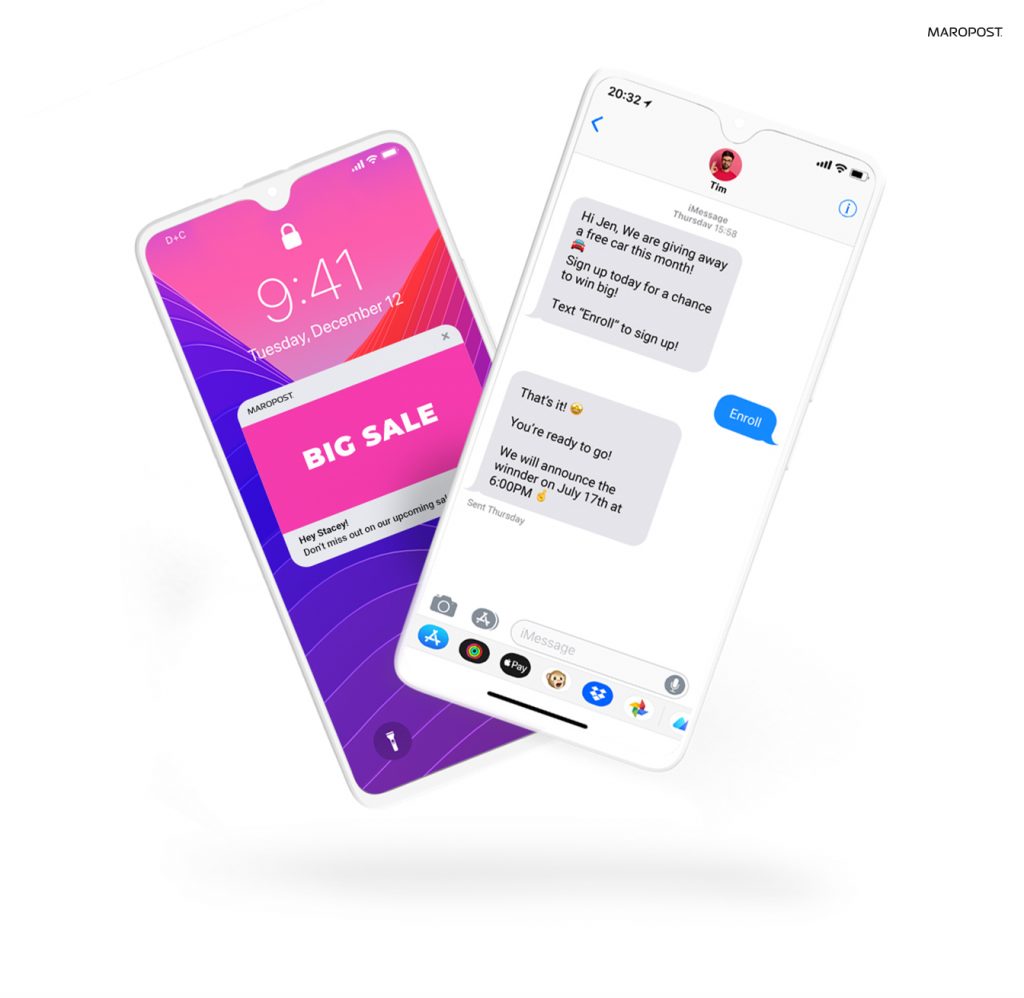Why are we talking about mobile marketing? There’s a 70% chance that you’re reading this on a mobile device. That’s why. Smartphones, tablets, and other mobile devices are changing the way consumers interact with brands, and consequently, vice versa.
Virtually everything is accessible on mobile today, from e-books to e-commerce. People don’t have to sit in front of a television to get entertained or watch the news. People don’t need a desktop or a laptop to read emails or shop online.
That means while commuting or hanging out with friends, consumers can constantly interact with your brand, irrespective of their location. Want to know more about mobile marketing?
Welcome to Mobile Marketing 101. Content Index:
- What is Mobile Marketing
- Why is Mobile Marketing Important
- Mobile Marketing Metrics and KPIs
- Mobile Marketing ROI
- Mobile Marketing Best Practices
- Mobile Marketing Platform
1. What is Mobile Marketing?
You can call it the most successful of all marketing campaigns. Mobile marketing is any digital marketing activity targeted at consumers on their mobile devices — smartphones, tablets, feature phones, and any other related devices, via websites, mobile apps, social media, emails, SMS, and MMS.
Mobile marketing campaigns usually include mobile advertising (social media, web and app ads), search optimization, mobile-friendly sites, location-based offerings, email marketing, in-app offerings, mobile coupons, QR codes, push notifications, SMS, etc.
2. Why is Mobile Marketing Important?
In 2017, Forbes highlighted five reasons mobile marketing is becoming more important, backed up by data.
(Check also our article: 5 reasons why you should make mobile marketing your priority).
1. Time spent on mobile devices is increasing
The average American spends over 500 hours per year navigating websites or talking on their mobile device, providing ample opportunity to capture their attention and get them talking about your brand on a device we use so frequently, it has become a part of our daily lives.
2. Mobile commerce and mobile marketing go hand-in-hand
For e-commerce alone, average smartphone conversion rates are up to 64% compared to the average desktop conversion rates. Traffic on e-commerce sites such as Amazon and eBay are largely from mobile devices.
3. Shoppers purchase in stores
Search engine optimization and a mobile-friendly website can give your business an edge when consumers are ready to purchase. Mobile technology allows consumers to shop and compare online while walking down the store aisle.

4. Short Message Service (SMS) open rates are higher than email
SMS has an open rate of 98%, and up to 90% of people who open the message will read it within three seconds. This is far higher than email marketing and other digital channels.
5. Mobile marketing reaches a broader market
Manufacturers are responding to consumer demand and developing faster, more powerful, and less expensive mobile devices. This means marketers and advertisers can reach a much wider audience and put their marketing messages into the hands of their consumers.
Still in doubt? In 2020, with the impact of a global pandemic, the importance of mobile marketing for brands is not debatable. Furthermore, the number of smartphone users worldwide today has surpassed three billion (Statista, August 2020).
That number is forecast to further grow by several hundred million in the next few years.
3. Mobile Marketing Metrics and KPIs
- Leads
How many quality leads did you get? The keyword here is “quality” and not necessarily quantity. Quality leads will most likely lead to conversions.
- Conversion Rate
The endpoint of having quality leads is to have conversions — that is, you need to measure how many people completed a sale or carried out an action on your page against the total number of people that visited the page.
- Attribution
Attribution helps you see the value each performance channel brings to your overall marketing result. Mobile marketing strategy is a multichannel based strategy, so you want to know the contribution of the various touchpoints in the consumer journey.
- Cost per Acquisition (CPA)
Acquisition shows you how many leads or conversion you have acquired. So, acquisition cost or CPA is the financial implication. It is a metric that measures the revenue impact of your marketing campaigns.
You can measure your CPA by understanding how much you need to spend in order to acquire or convert a quality lead.
- Engagement and Stickiness
Engagement is one of the most important metrics in mobile marketing and it can be measured across channels. For instance, you can measure the engagement rate for social media, as different from email, SMS and push notifications, which are all different from user engagement and stickiness for mobile applications.
- Lifetime Value (LTV or CLV)
Lifetime Value (LTV) or customer lifetime value (CLV) is a very relevant metric in mobile app marketing. You can measure the total amount of revenue driven by a user from the point of app installation until the user stops engaging with your app.
- Return on Ad Spend (ROAS)
The total ad spend is the money spent on mobile advertising and the return on ad spend (ROAS) is your gains. A successful performance marketing campaign will mean that you have a greater return compared to the cost of advertising.
4. Mobile Marketing ROI
Mobile marketing ROI varies from one channel to the other. Return on ad spend (ROAS) measures your gains against your spend in advertising. Return on investment means you have invested some money and a successful campaign is reflected by a greater return.
We have looked at some very important metrics that are useful in calculating your overall mobile marketing ROI. Cost per acquisition as we have seen will help calculate the total cost of acquiring or converting one quality lead.
Your mobile marketing ROI is not limited to the return on ad spend (ROAS) because it puts into consideration your total mobile marketing cost, which will include advertising spend, hosting fees or technology infrastructure, customer support, email marketing automation, app development, push notifications, etc.
In order to have the best results, you need to optimize your ROI in real-time. This means you will need a consistent data analysis for each performance channel in your mobile marketing campaign.
The best way to achieve this is to measure your ROI for each channel in real-time. For instance, calculate the amount spent on SMS marketing and push notifications and the returns gained from that campaign, separately from the total cost of acquiring active app users and the revenue driven by in-app activities.
5. Mobile Marketing Best Practices
Best practices serve as guide in implementing what works and avoiding pitfalls. These are some best practices in mobile marketing that you should be aware of:
- Mobile-friendliness
This is very important for website optimization. Is your website mobile-friendly or a complete put-off for mobile users? Your website should be optimized for mobile and search engines.
- Strategy
To create a successful mobile marketing strategy, you need to think like a content marketer. Essentially, mobile marketing should not be separated from a mobile-friendly content strategy. Also, personalization is very key, so your content has to be relevant, clear and targeted.
- Short and Simple
Your messaging should be driven by the keywords ”short”, ”sharp”, ”simple” and ”straightforward”. You need to keep in mind that mobile users have a short attention span. Therefore, you should pass across your message in the shortest time possible, no matter the channel or medium.
- Push Notifications
Leverage push notifications to provide your users with timely information. With personalization and proper targeting, push notifications can also be the perfect channel to use call-to-actions.
- Targeting and Retargeting
There are several detailed criteria with which you can target and retarget your audience on mobile. You can target consumers based on their location, interests, demographics, mobile device, phone model, internet connection type, and so on.
- Visuals
Use attention-grabbing visuals, such as short videos, gifs, or a carousel of images instead of still images. Simple still images with short and pointed copies can also do the magic when done correctly.
6. Mobile Marketing Platform
A Mobile Marketing Platform (MMP) is any solution designed to facilitate and optimize mobile marketing communications. With this solution, you can achieve a mobile-centric campaign and drive up your overall ROI. These are some of the essential features of MMPs:
- Automation
- Customer segmentation
- Multi-channel marketing
- Dynamic content marketing
- Scalability
- Responsive design
- Real-time engagement
- Mobile-centric analytics
Need to chat about your mobile marketing strategy?
More than 10,000 marketers use Maropost to engage with their prospects and customers through emails, SMS, social media and more. We’re here to help you growing your business!
Chat Now

